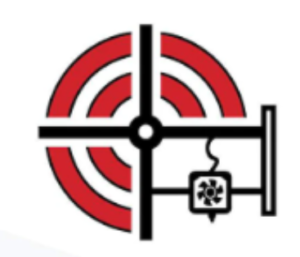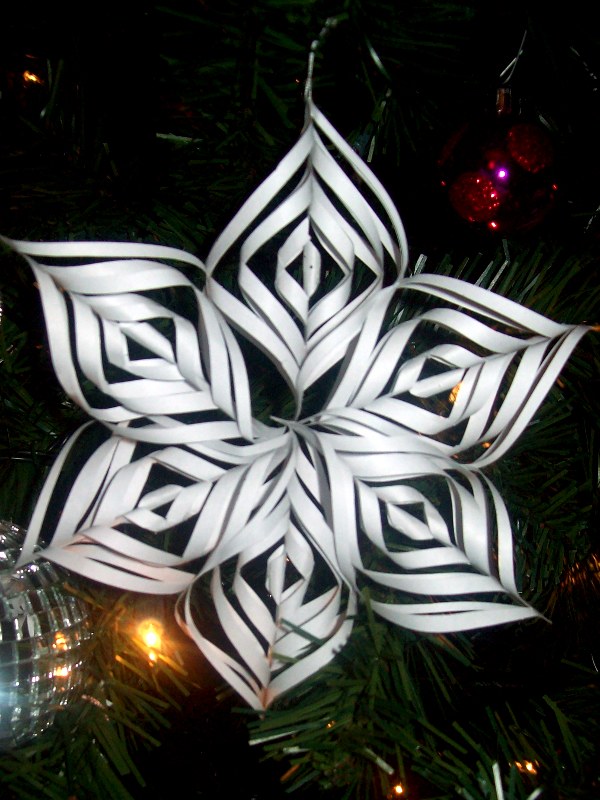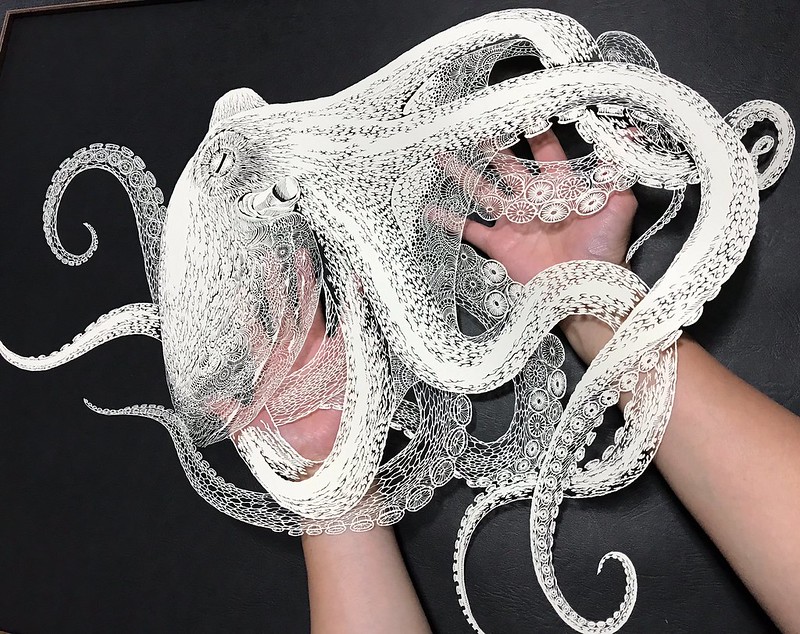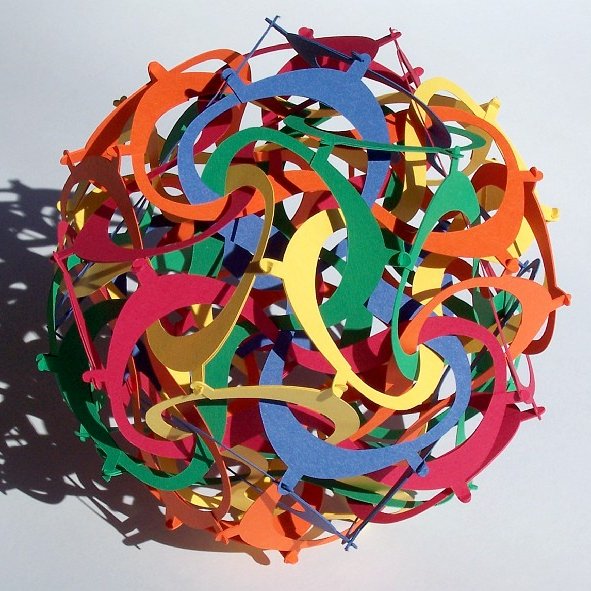Kirigami is a Japanese art and craft form where paper is cut and folded into intricate shapes. Often these shapes, accordion-like, can unfold into striking new forms. Whereas origami stretches centuries back into the past and is deeply intertwined with ceremony and culture, kirigami is a freer form of expression that may range from fine art to dioramas of contemporary buildings. Kirigami often is entertaining, and artists try to make beautiful, delicate things that surprise.
Kirigami snowflakes are very popular, and some shapes can be relatively flat, while others are 3D or can be moved. Some works are incredibly detailed and intricate, such as the octopus below.
The wonderful artist and mathematician George Hart, who is an early 3D printed art pioneer as well, has some lovely examples of modular kirigami on his delightful site.
Stylistically, a lot is possible in kirigami, and the field is very open to interpretation. But, Hart’s interest should tell you that kirigami is more than a hobby. By using cuts, creases, and folds, kirigami can be an optimal way to fold, unfold, twist, deform, reform, and move certain structures. As origami has continued to show value in things such as solar panel unfolding, people have become inspired by kirigami’s ability to optimize certain shapes. Currently, these are the most in-demand sensors and soft robotics. Going forward, kirigami can become a much bigger part of additive manufacturing and manufacturing in general for very specific needs and shapes.
The Utility of Kirigami
Generally, kirigami can be used to make things fold and unfold in a very specific way. This can make for more compact structures or for controlled (perhaps occurring in stages) deformation and folding. Additionally, structures could rotate, bend, twist, and act as a piston while being comprised of cut flat parts. With simple, cheap, easy-to-make engineered 2D planes, we can make 3D structures and even simple machines. Part properties of successive different layers can also be played with. Patterns, cuts, creases, and layers of dissimilar materials can all be changed. And you can quite easily adapt these design parameters to a unique situation.
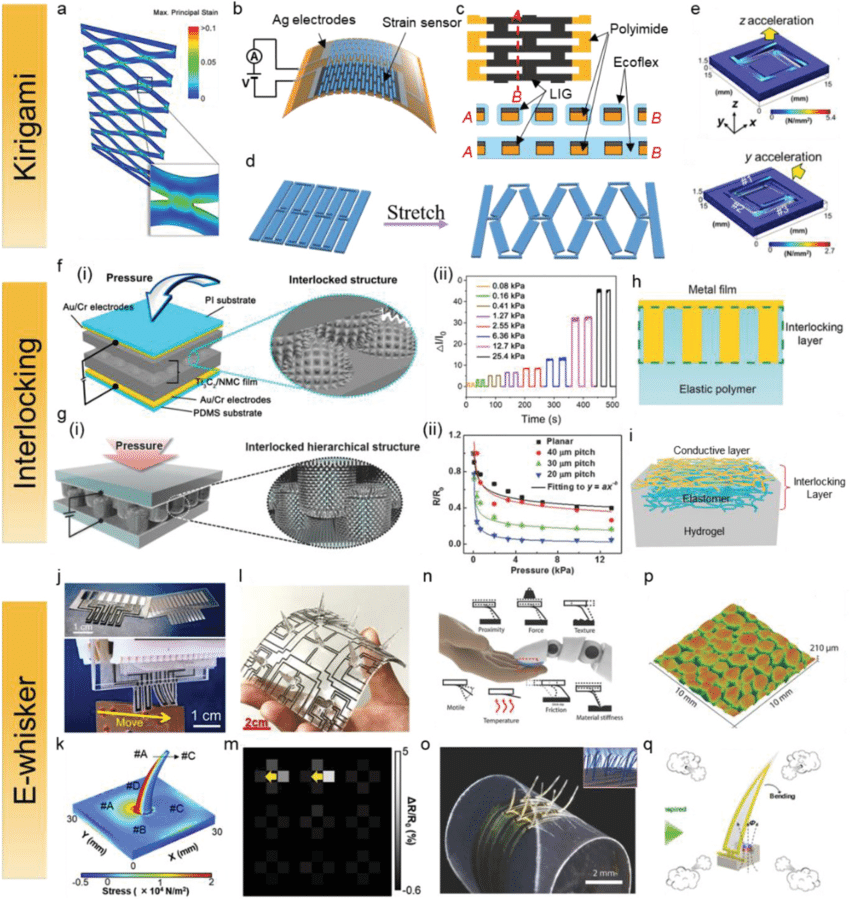
Of course, kirigami is not the only option.
For electronic devices, kirigami can be used to bend, fold, and make conformal objects like films, batteries, and other electronics that usually don’t like to be bent. This can be used to give them multiple positions and functions. It is most often used to make them fold into a storage and active space or to conform to the human body. Wearables, therefore, are a definite area of interest. At the same time, the organic soft robotics shapes also combine well with this technology. Pressure sensors, in particular, are a great combination with kirigami, since the device can conform to a shape but also bend them just so in order to measure pressure for that particular application or place.
If we look at wearables, sensors, 4D materials, meta materials, soft robotics, and electronic devices that are more integrated into your life, kirigami can provide definite advantages. Examples include routing circuits and sensors through VR headsets, smart glasses, foldable phones, smart textiles, thin film applications, more intricate smartphone wiring, and more complex wiring/sensors/circuits in machines.
SensorLand
Kirigami sensors are now increasingly made through 3D printing and point to a place where the 3D printed “4D material” can leave the lab and press release and enter the real world. Combined with shape memory properties, tunable performance, and additive manufacturing, generally we can improve the performance of sensors and make them more sensitive and efficient, and less expensive to fabricate. This matters because, although the IoT revolution seems overblown now, a lot of things around us, from buildings, infrastructure, and packages to our devices, are set to get a lot more sensors.
With fewer people in rich countries and a willingness to pay people less, comes a reliance on more sensors. We used to have a guy who made a career inspecting bridges. Now we wish to economize on him and not pay him a living wage. So we’re adding sensors to the bridge, so we need fewer inspections. This will happen everywhere, from production lines to light posts and Coke machines. Now, there are no really good ways to make these sensors. But, with additive and kirigami, we can make tuned, well-performing sensors inexpensively for many applications, including strain and pressure sensing. It’s perfectly theoretically possible to do this with current stage technology. We just need a few PT Barnums to make it real.
Kirigami & Additive
There’s already quite a bit going on in 3D printed kirigami sensors. This paper looks at biomedical and architectural sensors from Simon Fraser University, while this one and this other focus on architectural sensors. Nature loves kirigami and even has a design guide, and published a paper on piezoelectric sensors using buckling. Here, a piezoelectric nanogenerator can be used to power a device, while a more stretchable sensor has been designed. Here, a sensor senses pressure and displacement, and this one is for vibration. This paper looks at how stretch influences the device, and here it has been optimized for wearing on the body. Tunable and auxetic properties come together here. Health monitoring is also of interest, and heart monitoring in particular. Here, the sensors are personalized, and here microneedles are being made from ribbons. Temperature here influences shape memory, while strain is looked at with capacitive sensors here.
There’s a lot more happening, but in piezoelectric sensors, powering devices, sensors for in the body or on things, pressure, vibration, displacement, and strain, there is progress. With 3D printing, these sensors can be made in short production runs, customized, inexpensive, and at scale. I’ve been looking at improved movement and monitoring for walking and prosthetic devices, and kirigami is just a super important way to engineer a device that would monitor how you walk. Strain sensors for buildings are potentially huge, and kirigami seems like a great way to make these sensors fit, while also working well. In powering devices or running wiring, generally, 3D printing kirigami could also really help. This is a design methodology and an emerging research area that I recommend you watch. Time and time again, kirigami and 3D printing seem to be the design solution for complex problems that at one point could be found in billions of devices.
Subscribe to Our Email Newsletter
Stay up-to-date on all the latest news from the 3D printing industry and receive information and offers from third party vendors.
